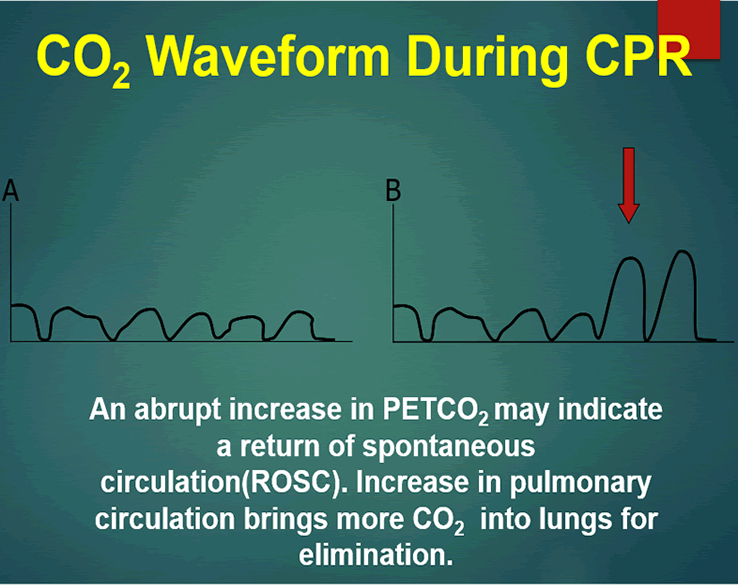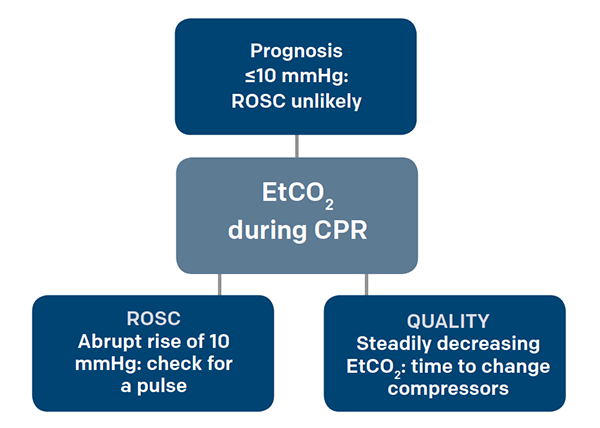low end tidal co2 during cpr
This may result from such ventilatory problems as high mean airway pressure or inadequate exhalation time resulting in overdistention or from. Cardio Pulmonary Resuscitation CPR ETCO2 concentration is a reliable index of effective heart compression during CPR which is associated with cardiac output 7 8The first sign of the return of spontaneous circulation ROSC during CPR is increase in ETCO2 therefore monitoring of ETCO2 provides very useful information to.

3 Waveform Capnography Showing Changes In The End Tidal Carbon Dioxide Download Scientific Diagram
ACLS is a series of evidence based responses simple enough.

. Waveform capnography represents the amount of carbon dioxide CO2 in exhaled air which assesses ventilation. Look for condensation during exhalation. Waveform capnography should be monitored in all intubated patients and displayed on the monitor as above.
The diagrams on this page show what happens if there is a blockage to an air space in the lungs. 5 A sudden rise in ETCO 2 may be an early sign of ROSC. It consists of a number and a graph.
Keeping this value below 30 centimeters of water has been shown to prevent lung injury and improve patient outcomes. Inspiratory Reserve Volume IRV. Loss of ETCO2 may be the first sign that CPR is needed.
Additional volume of air a person can inspire by a forcible inspiration. Invasive arterial blood pressure monitoring during CPR provides insight to blood pressures generated with compressions and medications. Journal of Cardiothoracic and Vascular Anesthesia Vol34 No5 p1125-1131.
The goal of Advanced Cardiovascular Life Support ACLS is to achieve the best possible outcome for individuals who are experiencing a life-threatening event. Dead-space ventilation results in ventilated alveoli with insufficient perfusion which leads to low ETco 2. MmHg Relate to the air we breath.
The intubation went well and you are now securing your ETT and connecting end-tidal waveform capnography to evaluate the tracing. 1Arm IV models. End-tidal CO2 should be verified during exhalation using monitor or ETD.
Although high and increasing ETCO 2 values are associated with increased rates of ROSC and survival after CPR do not use a low ETCO 2 value alone to decide if a resuscitation attempt should be. Do not close the browser or hit the refresh. An increase in ETCO 2 during CPR may indicate that ROSC has occurred.
This is end-tidal CO2 ETCO2 which is normally 35-45 mm Hg. 4 End-tidal CO 2 ETCO 2 reflects both the cardiac output produced and ventilation efficacy and may provide feedback on the quality of CPR. Its 100 free to take our practice exam.
The end-tidal CO2 in these people will be unnaturally low. This can be seen in a number of other conditions. Our TMC Practice Exam is designed to help you prepare for the Respiratory Therapist Multiple Choice Board Exam that is offered by the NBRC.
The SPUR II from Ambu the company that invented the Ambu Bag manual resuscitator provides users with exceptional tactile and visual feedback during resuscitation. Capnography is the monitoring of the concentration or partial pressure of carbon dioxide CO 2 in the respiratory gasesIts main development has been as a monitoring tool for use during anesthesia and intensive careIt is usually presented as a graph of expiratory CO 2 measured in millimeters of mercury mmHg plotted against time or less commonly but more usefully. Or alternatively deep anaesthesia and muscle paralysis will result in a similar picture.
ETCO2 levels reflect the adequacy with which carbon dioxide CO2 is carried in the blood back to the lungs and exhaled. Respiratory Volumes and Capacities Tidal Volume TV. However chest compression should not be interrupted based on this sign alone.
Confirming equal bilateral breath sounds with auscultation. The simplest example is a peanut stuck in one of the air passages in the lungs but the same process happens in pneumonia or pulmonary edemaBlood still flows past the air spaces but because there is no fresh air getting to the blood it cant take up any more oxygen. For instance a low-cardiac-output state generates a low end-tidal CO 2 because there is simply not enough flow across the pulmonary circulation.
Use portable chest x-ray. Anesthetic Management of Patients with COVID 19 Infections during Emergency Procedures. The bag walls are thin and responsive enabling the user to better gauge patient lung compliance during ventilation.
1 manikin for central vein cannulation IV Torso 3. During cardiac arrest if exhaled CO 2 is not detected confirm tube position with direct laryngoscopy Class IIa LOE C 110117 120 because the absence of CO 2 may reflect very low pulmonary blood flow rather than tube misplacement. INTRAVENOUS TECHNIQUES PERIPHERAL CENTRAL INTEROSSEOUS LINE IO 1.
Capnography is synonymous with patient safety during anesthesia and sedation and a boon during CPR Since the introduction of the first infrared CO 2 measuring and recording apparatus by Luft in 1943 capnography has evolved into an essential component of standard anesthesia monitoring armamentarium. Auscultate stomach to assure esophageal intubation didnt occur. The number is called capnometry which is the partial pressure of CO 2 detected at the end of exhalation ranging between 35 - 45 mm Hg or 40 57 kPa.
End tidal CO 2 EtCO 2. Total pressure of a gas is the sum of the partial pressures of the gas Expired CO2 measured PetCO2 mmHg in waveform Percentage Normal Levels PaO2 85-100mmHg PaCO2 35-45mmHg Percentage vs. Airway and ventilation interventions during cardiopulmonary resuscitation CPR and in those with a return of a spontaneous circulation ROSC follow a stepwise approach as the precise interventions are thought to depend on patient factors rescuer skills and the stage of the resuscitation 1 2Current guidelines for in-hospital cardiac arrest IHCA and out-of-hospital.
End-tidal CO2 ETCO2 detection requires air movement in and out of the lungs ventilation CO2 production from cellular metabolism and. End-tidal carbon dioxide ETCO2 is the level of carbon dioxide that is released at the end of an exhaled breath. End tidal CO 2 monitoring is represented as a number and a graph on a monitor.
End Tidal CO2 Detector. The number is capnometry which is the partial pressure of CO2 detected at the end of exhalation. 78 Nitrogen 21 Oxygen 1 CO2 and other gases Exhaled gases.
Just enter your name and email address to get started. Look for equal bilateral chest rise. 500 mL ie a healthy man can inspire or expire approximately 6000 to 8000 mL of air per minute.
The chest X-ray shows optimal position of the ETT you have the post-procedural analgesia and sedative agents on board and youre feeling good as you exit the resuscitation bay. You may need to use the lower end of the low tidal volume strategy for patients with stiff lungs using the 6 to 8 cckg range or even the ARDSNet range of 4 to 6 cckg to keep the plateau pressure down. The waveform is called capnograph and shows how much CO 2 is present at each phase of the respiratory cycle.
Confirmation of endotracheal tube position by colorimetric end-tidal CO 2 detector may be altered by the. 11172009 4 Measuring End Tidal CO2 Daltons Law. Advanced cardiac life support.
1 roll adhesive tape or ½ inch ribbon gauze. End-tidal clearance must be evaluated in the context of the patients perfusion status. When you finish the exam hit Submit and the results will be shown here at the top of this page.
Volume of air inspired or expired during a normal respiration. What is end-tidal CO2 etCO2. Available evidence has established that ETCO2 measurement can provide an indication of cardiac output and pulmonary blood flow24 Non.
EtCO2 is a measurement of the partial pressure of CO2 in gas expired at the end of exhalation when exhaled gas will most closely resemble the alveolar CO2 concentration.

Cpr Mobile Code Stand With Capnograph Capnography

End Tidal Co2 Emergency Medicine Icu Nursing Paramedic School

Pv Card Continuous End Tidal Co2 Monitoring In Cardiac Arrest Cardiac Nursing Cardiac Arrest Medical Knowledge

Quantitative Waveform Capnography Acls Medical Training

Waveform Capnography In The Intubated Patient Emcrit Project

Capnograph Note Try To Maintain Etco2 Above 10mmhg During Cpr Respiratory Therapy Student Emergency Nursing Nurse Anesthesia

The Impact Of Ventilation Rate On End Tidal Carbon Dioxide Level During Manual Cardiopulmonary Resuscitation Resuscitation

Waveform Capnography Is A Commonly Used Monitor In The Operating Room And Is Increasingl Icu Nursing Respiratory Therapy Student Respiratory Therapist Student

Use End Tidal Capnography For Placing Orogastric Nasogastric Tubes And Cpr Page 2 Of 4 Acep Now Page 2